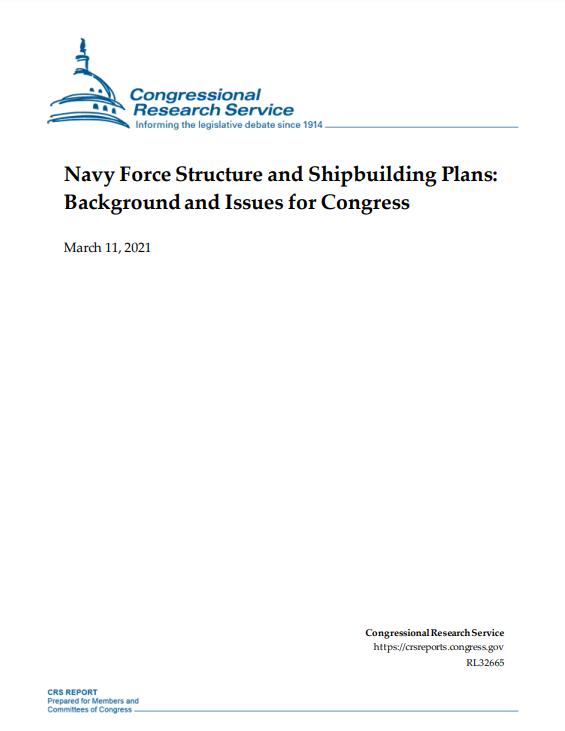
The Congressional Research Service report for “Navy Force Structure and Shipbuilding Plans: Background and Issues for Congress” published on March 11, 2021. The summary of the report as follows.
Summary
The current and planned size and composition of the Navy, the annual rate of Navy ship procurement, the prospective affordability of the Navy’s shipbuilding plans, and the capacity of the U.S. shipbuilding industry to execute the Navy’s shipbuilding plans have been oversight matters for the congressional defense committees for many years.
In December 2016, the Navy released a force-structure goal that calls for achieving and maintaining a fleet of 355 ships of certain types and numbers. The 355-ship goal was made U.S. policy by Section 1025 of the FY2018 National Defense Authorization Act (H.R. 2810/P.L. 115-91 of December 12, 2017). The Navy and the Department of Defense (DOD) have been working
since 2019 to develop a successor for the 355-ship force-level goal. The new goal is expected to introduce a new, more distributed fleet architecture featuring a smaller proportion of larger ships, a larger proportion of smaller ships, and a new third tier of large unmanned vehicles (UVs).
US Navy’s 355-Ship Goal

On December 9, 2020, the outgoing Trump Administration released a document that can be viewed as its own vision for future Navy force structure and/or a draft version of the FY2022 30-year Navy shipbuilding plan. The document presents an envisioned Navy force-level goal for achieving by 2045 a Navy with a more distributed fleet architecture, including 382 to 446 manned ships and 143 to 242 large UVs. The Biden Administration can choose to adopt, revise, or set aside this document. Biden Administration officials have stated Navy shipbuilding will be a top area of focus for the Administration’s review of the Trump Administration’s defense plans and programs.

The Biden Administration will submit the Navy’s proposed FY2022 budget later this year and is required by law to additionally submit an FY2022 30-year (FY2022-FY2051) Navy shipbuilding plan in conjunction with its proposed FY2022 defense budget. Although the executive branch is required by law to submit a 30-year shipbuilding plan each year in conjunction with its annual
budget submission, past Administrations have sometimes chosen to not submit a 30-year shipbuilding plan during their first year in office, on the grounds that they were spending that year reviewing and revising the previous Administration’s defense strategy, plans, and programs, so as to create a basis for subsequently devising a 30-year shipbuilding plan.
The issue for Congress is whether to approve, reject, or modify the Navy’s proposed FY2022 shipbuilding program and the Navy’s longer-term shipbuilding plans. Decisions that Congress makes on this issue can substantially affect Navy capabilities and funding requirements, and the U.S. shipbuilding industrial base. Key questions for Congress include the following:
- Does the Biden Administration plan to present a new force-level goal to replace the 355-ship goal, and, if so, when?
- Is the Navy’s force-level goal (either the existing 355-ship goal or a possible successor goal) appropriate for supporting U.S. national security strategy and U.S. defense strategy? Is the more distributed fleet architecture envisioned by the Navy the most cost-effective fleet architecture for meeting future mission needs?
- Will the Navy’s proposed FY2022 shipbuilding funding request, five-year shipbuilding plan, and 30-year shipbuilding plan (if submitted) be consistent with the Navy’s force-level goal?
- Given finite defense resources and competing demands for defense funds, what is the prospective affordability of the Navy’s shipbuilding plans?
- Does the U.S. shipbuilding industry, including both shipyards and supplier firms, have adequate capacity for executing the Navy’s shipbuilding plans?
Click on the image to see the whole report:



